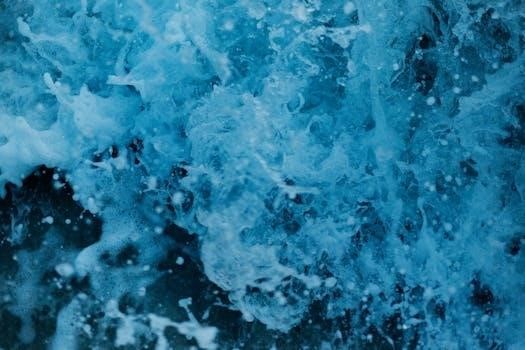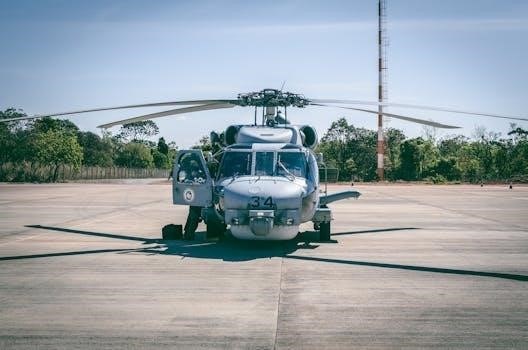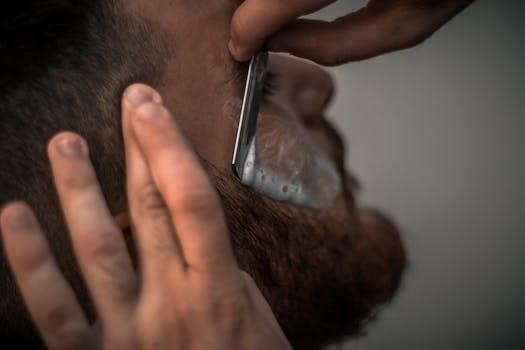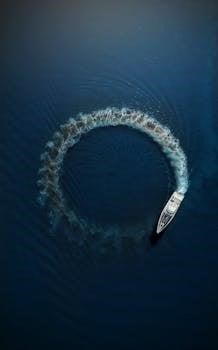
The Navy No Shave Chit, officially a waiver, addresses Pseudofolliculitis Barbae (PFB). This condition causes irritation from shaving. It allows sailors with PFB to avoid shaving, and is a medical accommodation. Previously, it required carrying a physical copy, this is no longer the case;
Overview of Pseudofolliculitis Barbae (PFB)
Pseudofolliculitis Barbae, commonly known as PFB, is a skin condition arising from shaving, particularly prevalent in individuals with curly or coarse hair. It manifests as inflammation, ingrown hairs, and sometimes painful bumps or pustules on the face and neck. This occurs when shaved hair curls back into the skin, causing an inflammatory reaction. The condition is often exacerbated by close shaving and can lead to discomfort, skin irritation, and even secondary infections. The Navy has addressed PFB through the issuance of temporary or permanent no-shave waivers, allowing affected sailors to grow beards. Understanding PFB is crucial for the Navy’s management of grooming policies and ensuring the health and readiness of its personnel, impacting how the Navy handles its no-shave chit and related regulations. The condition is treatable with specific creams, and can sometimes require re-evaluation to provide a more effective course of action.

Navy Policy on Facial Hair
Historically, the Navy had strict regulations on facial hair. While beards were once allowed, they were banned in 1984. Currently, mustaches are permitted, and beards are allowed only with specific medical accommodations, such as a no-shave chit.
Historical Context of Navy Facial Hair Regulations
The U.S. Navy’s policies regarding facial hair have undergone significant changes throughout its history. In earlier periods, beards were not uncommon among naval personnel. However, as grooming standards evolved, stricter regulations were introduced. The Navy’s approach to facial hair has been influenced by factors ranging from practical considerations to evolving societal norms. Before the ban in 1984, beards were sometimes seen, and then the policy shifted towards a clean-shaven appearance. This change reflected a broader trend within the military toward uniformity and a more professional image. The regulations were also impacted by perceived hygiene concerns and the need for proper sealing of equipment like gas masks. The allowance of mustaches remained, but full beards were largely prohibited for many years, until recent changes.
Current Regulations on Facial Hair
Currently, the Navy’s regulations on facial hair are specific and detailed. While beards are generally prohibited, there are exceptions for sailors diagnosed with Pseudofolliculitis Barbae (PFB), a skin condition caused by shaving. These individuals may be granted a “no-shave chit,” which allows them to grow a beard. However, even with a no-shave chit, the beard must be maintained within certain guidelines. It should be neatly trimmed and not exceed a specific length. The Navy also permits outlining or edging of the beard for PFB sufferers, unless it causes further irritation. Handlebar mustaches, goatees, and eccentric styles are still not permitted. These regulations are designed to balance the needs of individual sailors with the Navy’s standards for a professional appearance and operational readiness.

No Shave Chit and PFB
The no-shave chit is directly linked to Pseudofolliculitis Barbae (PFB). PFB is a skin condition triggered by shaving. This waiver allows affected sailors to grow facial hair. It addresses the irritation caused by shaving.
Definition and Causes of PFB
Pseudofolliculitis Barbae, or PFB, is a chronic inflammatory condition of the hair follicle. It’s primarily caused by shaving, where the hair curls back into the skin, causing irritation. This results in painful bumps and ingrown hairs, commonly seen in areas with coarse, curly hair. The condition is prevalent among individuals with specific hair types, and is not related to poor hygiene. PFB manifests as redness, swelling, and sometimes infection in the affected areas. The condition can range from mild to severe, impacting the individual’s comfort, and can be a source of physical and emotional discomfort. The Navy recognizes the impact of PFB and provides accommodations through the no-shave chit.
Temporary vs. Permanent No-Shave Waivers
The Navy previously issued both temporary and permanent no-shave waivers, also known as no-shave chits. Temporary waivers were granted for sailors experiencing short-term PFB flare-ups. These allowed for beard growth during the healing process, and were subject to review. Permanent waivers were given to individuals with chronic PFB. However, the Navy has since eliminated the permanent waiver system. Sailors previously holding permanent waivers are required to undergo medical re-evaluation. The current focus is on treatment and management of PFB rather than permanent exemptions. This shift reflects the Navy’s commitment to addressing the root causes of PFB and promoting sailor health. The new approach aims to provide effective solutions for PFB through ongoing medical care.
Changes in Navy Policy
Recent updates include eliminating the need to carry the physical waiver. Sailors can now optionally outline or edge their beards. Medical re-evaluations are now required for those with previous permanent waivers. Treatment regimens have been updated.
Elimination of Carrying the Waiver
A significant change in the Navy’s policy regarding the no-shave chit is the elimination of the requirement for sailors diagnosed with Pseudofolliculitis Barbae (PFB) to carry a physical copy of their waiver. This update, implemented through a recent NAVADMIN, simplifies the process for sailors who are authorized to grow facial hair due to this condition. Previously, sailors were required to keep the waiver on their person at all times, which could be inconvenient and cumbersome. This change reflects the Navy’s commitment to streamlining administrative processes and reducing unnecessary burdens on its personnel. The decision to remove this requirement was driven by feedback from sailors and waterfront leadership, who highlighted the impracticality of constantly carrying the document. This policy adjustment allows sailors to focus on their duties without the added concern of misplacing or damaging their waiver. The elimination of this mandate is a positive step forward, demonstrating the Navy’s responsiveness to the needs of its sailors. This change also reflects a move towards digital record keeping.
Updates on Beard Outlining/Edging
Recent policy updates have introduced a change regarding the outlining or edging of beards for sailors with authorized facial hair due to Pseudofolliculitis Barbae (PFB). According to the latest NAVADMIN, sailors diagnosed with PFB are now permitted to optionally outline or edge their beards. This change allows for a more groomed appearance while still accommodating the medical needs of those with PFB. This contrasts with previous policies that did not explicitly allow for such grooming practices. However, it’s crucial to note that this outlining or edging is not mandatory, and sailors are advised to discontinue this practice if it causes any skin irritation or an outbreak. The Navy emphasizes that the health and well-being of its sailors remain paramount. This optional outlining/edging provision offers a balance between maintaining a professional appearance and addressing the specific needs of sailors with PFB. It reflects a more flexible and considerate approach to grooming standards, acknowledging that not all sailors can achieve a clean-shaven look without experiencing discomfort.
Medical Re-evaluation and Treatment Regimens
The Navy has implemented a requirement for medical re-evaluation for service members previously granted permanent no-shave waivers. Within six months of the revised BUPERSINST 1000.22C release, these individuals must undergo a new medical assessment. This re-evaluation aims to ensure that the treatment regimens are current and effective in managing Pseudofolliculitis Barbae (PFB). The Navy maintains that PFB is a treatable condition, and updated treatment options are now being emphasized. These options may include specialized face creams and other medical interventions. The re-evaluation process allows for the personalization of treatment plans, catering to the specific needs of each sailor. The goal is to move away from the sole reliance on no-shave waivers towards actively managing the condition. This proactive approach reflects the Navy’s commitment to the health and well-being of its sailors, ensuring they receive appropriate medical care while still maintaining mission readiness.

Impact and Implications
Sailor feedback has driven policy changes, with the Navy prioritizing health and mission readiness. The updated regulations regarding PFB and no-shave chits reflect a commitment to both sailor well-being and operational effectiveness.
Sailor Feedback and Policy Changes
The Navy has actively responded to concerns raised by sailors and leadership regarding grooming policies, particularly those related to Pseudofolliculitis Barbae (PFB). These concerns, voiced through various channels including the MyNavy Portal, have prompted significant updates to the regulations surrounding the no-shave chit. The elimination of the requirement to carry the physical waiver is a direct result of sailor feedback. Furthermore, the allowance for optional beard outlining or edging, while still adhering to standards, acknowledges the practical needs of those with PFB. These changes represent the Navy’s dedication to listening to its personnel and adapting policies to better support their health and well-being, ensuring a more effective and satisfied force. The policy changes intend to balance readiness and sailor needs.
Safety and Mission Readiness
The Navy’s approach to PFB and the no-shave chit is directly linked to safety and mission readiness. By addressing PFB effectively, the Navy aims to minimize distractions and discomfort that could impact performance. The updated policy ensures that sailors can maintain operational effectiveness without being hindered by skin irritation or infections. Allowing for beard outlining, while maintaining a professional appearance, is a balancing act between individual needs and uniform standards. The policy changes, including the elimination of the need to carry a physical waiver, also improve efficiency and reduce administrative burdens. The Navy emphasizes that these changes are not solely about personal comfort but about preserving the health and operational readiness of the entire force, ensuring they are fully capable of fulfilling their duties. This balance is crucial.

on Navy No Shave Chit
The Navy has updated its no-shave chit policy, reflecting a focus on sailor health and operational readiness. Key changes include optional beard outlining and eliminating the need to carry the waiver.
Recent updates to the Navy’s policy regarding the no-shave chit, related to Pseudofolliculitis Barbae (PFB), mark a significant shift in how the service manages this condition. One of the most notable changes is the elimination of the requirement for sailors diagnosed with PFB to carry a physical copy of their facial hair waiver or “no-shave chit” while in uniform. This change streamlines the process and reduces administrative burden. Furthermore, the Navy now permits sailors with PFB to optionally outline or edge their beards, provided that doing so does not cause further skin irritation or outbreaks. This modification offers a balance between grooming standards and individual health needs, allowing for a more personalized approach to managing PFB. These policy updates demonstrate the Navy’s commitment to the health, safety, and mission readiness of its sailors, reflecting feedback from both sailors and leadership. Additionally, service members previously issued permanent no-shave waivers will undergo medical re-evaluation and treatment plans within six months of the revised instruction’s release.